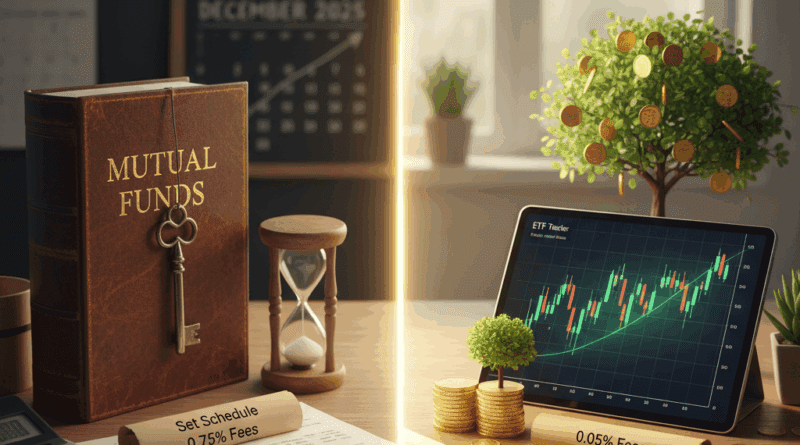Investing in ETFs vs. Mutual Funds: Which is Better for Long-Term Growth?
When planning for long-term growth—whether it’s for retirement or a college fund—investors inevitably face the choice between Exchange-Traded Funds (ETFs) and Mutual Funds. Both offer crucial diversification benefits, but their fundamental structures impact everything from your costs to your annual tax bill.
In 2025, the debate focuses heavily on cost efficiency and tax minimization. This comprehensive guide breaks down the core differences, helping you determine which vehicle is better suited for your long-term, wealth-building strategy.
Structure and Pricing: How They Impact Your Wallet
The single biggest difference between ETFs and Mutual Funds is how they trade, which directly influences their cost structure and tax efficiency.
1. Trading Mechanism (Liquidity)
- Mutual Funds: Can only be bought or sold once per day after the market closes, based on the end-of-day Net Asset Value (NAV). This means you submit an order, but don’t know the exact price until later.
- Best For: Dollar-Cost Averaging (DCA) and automated, regular investing.
- ETFs: Trade like stocks on an exchange throughout the day. You can set limit orders, trade instantly, and capitalize on price movements.
- Best For: Active traders or those wanting full control over the execution price.
2. Costs (Expense Ratio)
The Expense Ratio (ER) is the annual fee taken from the fund’s assets to cover management costs.
- ETFs: Generally have lower Expense Ratios than actively managed mutual funds (often 0.03% to 0.20% for popular index ETFs). This is because most ETFs are passively managed (they simply track an index).
- Actively Managed Mutual Funds: Generally have higher Expense Ratios (often 0.50% to 1.50%), as they pay managers to actively try to outperform the market, a feat most fail to achieve over the long term.
The Long-Term Decider: Tax Efficiency
For long-term investors holding assets in taxable brokerage accounts, tax efficiency is a significant factor. ETFs have a structural advantage over traditional mutual funds:
FeatureETFsMutual Funds (Actively Managed)Impact on Long-Term GrowthCapital Gains DistributionsRare. Due to their unique redemption structure (in-kind transfers), ETFs rarely realize capital gains that must be distributed to shareholders.Common. When fund managers sell stocks for a profit inside the fund, those gains are distributed annually to all shareholders, triggering a taxable event for you, even if you didn’t sell any shares.ETFs minimize annual taxes, allowing your money to compound faster, which is key for long-term growth.Transaction FeesOften $0 commission (on major brokers).Often $0 commission (on major brokers). However, some still have sales loads (front-end or back-end loads) that act as commissions.Look for no-load, no-transaction-fee options in both categories.
Which Investment Vehicle is Right for Your Strategy?
Choosing between an ETF and a Mutual Fund is less about which is superior, and more about how you plan to invest:
Consider ETFs if:
- You prioritize Cost and Taxes: You are investing in a taxable brokerage account and want the lowest fees and highest tax efficiency.
- You are a DIY Investor: You prefer to make one-time lump-sum investments and manage your portfolio allocation manually.
- You Want Niche Exposure: You want to invest in highly specific sectors, themes (e.g., green energy), or commodities.
Consider Mutual Funds if:
- You Use Automatic Investing (DCA): You prefer to set up automatic monthly transfers of a fixed dollar amount, as mutual funds allow you to buy fractional shares easily.
- You Have a Retirement Account (Tax-Deferred): Since taxes are deferred in accounts like 401(k)s or IRAs, the tax efficiency advantage of ETFs disappears. You can simply choose the lowest-cost, no-load fund available.
- You Prefer Simplicity: You like knowing your purchase will always be at the fair NAV price, without the intraday price volatility of an ETF.
Conclusion: The Long-Term Winner is Low Cost
For long-term growth, the biggest factor determining success is keeping your costs low. While ETFs generally hold the advantage in terms of tax efficiency and lower expense ratios for passive strategies, the key is to choose an option (whether an ETF or a passively managed Index Mutual Fund) that has fees under 0.10% and aligns with your investment style.
